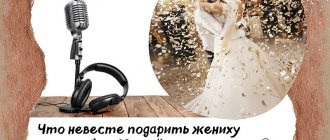Organizing a wedding is a troublesome task, because you need to follow traditions and think through the nuances to make this solemn event unforgettable. If previously most of the problems fell on the shoulders of the newlyweds, turning a joyful event into a series of worries, a “holiday for the guests,” now everything is beginning to change, and wedding worries are shared among themselves by relatives and friends of the bride and groom, who are not indifferent to the long-awaited happiness of the newlyweds. Therefore, at weddings, instead of the usual groomsman or best man, you can increasingly meet several young men at once.
Who can be witnesses at a wedding? Witnesses at a wedding, groomsmen and groomsmen: responsibilities and signs
Different people meet at weddings. Who could it be? Witnesses at the wedding, relatives and friends. A wedding is a wonderful event. It has various signs and generally accepted customs. Witnesses play an important role in this holiday. Therefore, it is worth deciding in advance who exactly is capable of holding this position. What should witnesses do? Who can get this position? Understanding this is not as difficult as it seems!
Is it possible to get married without witnesses: 4 main stages of a wedding
Download this article
The sacrament of wedding is the conclusion of marriage in the Orthodox Church. The newlyweds receive a blessing from the priest for their future family life. Only baptized and believing people can get married.
First you need to prepare for such an event spiritually. And approach this consciously. After all, young people will be responsible before God for their deeds and thoughts. You shouldn't do it because your neighbors did it.
After the wedding, people will not be able to dissolve their marriage. This also needs to be thought about in advance.
Wedding is one of the seven sacraments of the Russian Orthodox Church
This ceremony is performed in the presence of witnesses and guests. But many people wonder, is it possible to get married without witnesses? Let's try to figure this out.
Observers
There are many important people at our celebration today. Who could it be? Witnesses at the wedding! The point is that the role of these people used to be extremely important. Witnesses confirmed the fact of mutual consent of the loving couple to enter into marriage. It was necessary to nominate one person from the groom's side and one from the bride's side.
Now witnesses are the most ordinary observers. In the modern world, their significance is not so important. But when the registration takes place at the registry office, these people put their signatures in a special book. This is how they confirm the marriage of the bride and groom. Witnesses are far from the most important people for marriage. But the tradition of their choice has still been preserved. With these persons, the wedding usually takes place according to all the rules and traditions.
Who should hold the crown at the wedding?
There are no strict rules about who exactly should hold the crown over the heads of the newlyweds. This may be a male or female witness. The basic rule is that when holding the crown above the head of the bride or groom, you cannot lower it, you can only change your hand without lowering the crown. The tradition that a man should hold the crown over the groom, and a woman over the bride, came from the practice of the registry office, when a couple of a girl and a guy are sure to act as witnesses. Previously, the boyfriends of young people were exclusively men.
23 Oct 2022 at 11:22 PDT
If there are no guarantors present at the sacrament, then the crowns are simply placed on the heads of the newlyweds.
Bride's side
There should be an important person on each side of the bride and groom. Who could it be? Witnesses at the wedding! It has already been said that it is necessary to choose 1 person on each side - both from the bride and from the groom. At the same time, it is important to remember: the girl is nominated on her side, and the man on his side.
The future wife should choose one girl among her friends who will always be nearby. This is my friend. At the wedding she plays the role of a witness. At the table she is seated closest to the bride.
The witnesses are, one might say, the best friends of the hero of the occasion. And they play a really important role. Especially if you hold a wedding with ransom and kidnapping of the bride. But more on that later. First, remember that there can be no more than one witness at one celebration. This is an important rule. But there can be as many bridesmaids (ordinary guests).
Wedding gifts for newlyweds
It is customary to give gifts at a wedding, just like at a wedding. Most often they give wedding icons or other religious items: the Gospel, prayer book, lamp and candles. You can give a pendant with an image of the Virgin and Child.
Pendant, SOKOLOV (price on the link)
Or Saint Matrona.
Gold pendant with enamel, SOKOLOV (price on the link)
You can also donate household items: bedding sets, tea sets or household appliances.
A wedding is an important step for spouses who decide to link their lives before God for life together even after death. Such an important decision should not be made in haste or haste. It is important to remember that the role of witnesses at the ceremony is symbolic and great responsibility for the marriage lies with the spouses.
From the groom's side
The groom's witness also plays an important role. As you might guess, this is the person who is the best friend of the hero of the occasion. The one whom the groom trusts. Just like on the bride’s side, the future husband puts forward only one witness. It is appointed in advance. Now this is done at the stage of sending out invitations.
The witness is an important person. Some compare this person to the groom's "right hand" at the wedding. He will have to help his future husband in competitions and at ransom. We can say that the groom is the groom's keeper. And the groomsman at a wedding is the bride’s keeper. Previously, their presence was considered extremely important. Now, as already mentioned, this is not a mandatory point for a wedding.
Where to find
If the newlyweds decide to hire a wedding planner, then the question arises of how and where to look for him.
If none of your friends have hired a manager or cannot evaluate his work as good, the Internet will come to the aid of the newlyweds. On virtual bulletin boards you can often find advertising messages from managers with a list of their services.
In addition, now almost every specialist has his own website, where he publishes information about himself, photos and videos from events. You can also read customer reviews there.
If this option does not work, then you can contact a special agency involved in organizing holidays. Many of them specialize directly in weddings and will be able to help you find a competent assistant in accordance with the tastes and capabilities of the newlyweds.
Who could it be
From the bride and groom's side, 1 person is chosen for the wedding. I wonder who it could be? Witnesses at weddings used to be chosen seriously. There were a lot of rules to follow. It is already clear that one best friend should be chosen from the bride’s side, and one best friend from the groom’s side. They will be witnesses.
Previously, it was believed that only single people could be boyfriends and boyfriends. Those who have not yet married at all. And it was considered a good omen if the witness and the witness started a relationship and liked each other. This supposedly served as a symbol of the friends' strong marriage.
Is it possible to get married in a church without witnesses?
Previously, when weddings were the only official way to enter into marriages, the role of witnesses was important, as they signed the parish register and confirmed that the spouses could get married. Is a witness needed nowadays? Now the role of witnesses is quite symbolic, it is rather a tribute to tradition.
They act as spiritual guides to the couple getting married.
But their presence is not necessary at the ceremony.
If for some reason the newlyweds do not have the opportunity to invite guarantors, then the wedding sacrament is performed without them. You just need to warn the priest in advance about their absence. The presence of guests and parents at the sacrament is permissible at the request of the newlyweds.
26 Oct 2022 at 12:57 PDT
Sometimes young people want to get married secretly from everyone, so they cannot call witnesses to the sacrament. In this case, it is important to remember that the priest must know about the reasons that prompted the newlyweds to get married in secret, since the blessing of the parents is desirable for the wedding.
Responsibilities of a witness
The bride and the witness are two girlfriends. As we found out, the groomsman plays an important role if all the wedding traditions are maintained. She is the guardian of the bride. What are her responsibilities?
The to-do list begins long before the celebration. Now the witnesses must help the bride prepare for the holiday. They help you choose a makeup artist, hairdresser, dress, and accessories. On the wedding day, they can give makeup to the bridesmaid who is getting married. It is mandatory to help the bride get ready for the registry office. If a ransom is carried out, then the witness must take an active part in it - testing the “strength” of the groom and his witness.
Then, throughout the day, the groomsman plays the role of the bride’s assistant. She monitors her friend’s appearance so that she looks beautiful all the time, helps in organizing “snacks” during walks after painting in the registry office, during competitions and quizzes she takes an active part in entertaining guests, collects money “for the girl”, carries a bouquet brides
Witness activity
It is now clear who can be a witness at a wedding. And even the tasks of the witness are no longer a secret. What does a witness do? In principle, his duties are somewhat similar to the activities of a groomsman. The groom's best friend helps organize the bachelor party, if there is one. He chooses a suit, tie and other accessories that allow him to create the image of his future husband. Of course, his friend will keep an eye on his appearance on the day of the celebration.
The witness actively participates in competitions, helps his partner getting married to buy the bride, and is “responsible” for the rings and documents at the registry office. He collects money “for the boy” and, together with the witness, holds an auction of the first piece of the wedding cake. If the groom comes to pick up the bride by car, the witness must organize the decoration of the car. At the registry office, it is usually the groomsman who gives the rings to the newlyweds, and the groomsman at this time holds the bride’s bouquet.
One more point - the witness must have a certain amount of money with him in small bills. Changes, small “paper” money - they make life much easier. It is not necessary to take large sums with you; about a thousand rubles is enough.
Witnesses and witnesses have their own signs. It is believed that if these people are married, then they will pass on their happiness to those getting married, but they themselves will lose it. And supposedly single people attract joy to their future family.
Under no circumstances should widows and widowers be called as witnesses. This will bring disaster to the couple. It is not recommended to take namesakes as witnesses.
You should also choose your clothes wisely. The witness's dress should be pink or blue - this attracts prosperity and love to the new family. Bridesmaids are not allowed to wear black.
If the bridesmaid helps the bride with makeup, you cannot stand between the future wife and the mirror - this way the friend will take all the happiness and luck for herself. Previously, it was believed that this is how girls get up, intending to take the groom away.
For luck, pins are pinned on young people's clothes, and sprinkled with rice and coins for well-being. Young people should not cross the road. Therefore, at the celebration, witnesses must go in front of the newlyweds.
Natalia Kudenko, Special Wedding Agency
— How did you get into the wedding industry?
I got into this field quite simply - by organizing my own wedding in 2012. Moreover, we started with a list of 12 people in the Moscow region, and ended with a list of 90 people on an island abroad, and it was crazy :) This is where it all started. In another life - in the life “before” - I was a lawyer, engaged in corporate law, and this helped me a lot in my future work.
— How would you describe your profession in one word?
Solution. After all, in the process of work I have to take them constantly - from the most insignificant to the very important.
— Tell us about the funniest incident from your practice
We have some reason to smile in every project! However, the first thing that comes to mind: I had one very wonderful couple
The groom, who has preferred a casual style of clothing all his life, decided to buy himself a tuxedo for such an important occasion as a wedding - and this was indeed a very important step for him. Moreover, the couple went abroad to buy a suit and dress
And now, imagine the wedding day: I come to pick up the groom, he solemnly puts on his tuxedo, and suddenly we both realize that in the joy of shopping, he forgot to hem his pants! (The pants were 40 centimeters longer than the groom). Of course, in the end everything worked out for us - everything was pinned and hemmed. But it was a real challenge, albeit a pretty fun one.
- Many girls dream of such a profession - creating weddings. How and where (and, most importantly, is it possible at all) to learn this?
Now there are many courses and portals. Usually I watch foreign, American portals. But I cannot give any specific recommendations, since everything in my practice was obtained only from my own experience.
— The main difficulties of the profession. What to expect and what to fear?
The most dangerous thing is the lack of room for error. There are no second chances to do a wedding well - you have to create the perfect fairytale day the first time.
— How does a wedding planner’s day begin? And how does it end?
My day starts with checking my email. Since we have many foreign projects, and, for example, in China the day begins much earlier than here, there is quite a lot of mail in the morning. Then during the day there are meetings with clients and contractors. The day usually ends the same way: checking mail and paperwork, painstaking work.
— How does your family react to an irregular schedule?
In this case, I am incredibly lucky because my husband has the same crazy, irregular schedule that I do. If it weren't like that, it would be difficult. Of course, I try to save Sunday for my family, but, unfortunately, this does not always work out.
— “A constant holiday”—this is exactly what your work looks like to an outside observer. But is it?
Any holiday from the inside is a big, difficult job. This is a profession in which you are constantly, work 24/7. This is work, including with money, with contractors, with accounting, with taxes - that is, the same business as any other.
— Professional burnout and how to avoid it. Do you manage to maintain a balance between work and hobbies?
Until now, I have not experienced professional burnout. I guess I'm lucky - I really love my job. And almost all of my hobbies in one way or another have something in common with work - I live by it. This is probably more a question about family: how to maintain balance. With the arrival of a child in my life, it is very difficult to maintain such a balance, because, of course, I want to devote a lot of time to him. But clients and contractors require the same amount of time from me.
Duties of groomsmen and groomsmen at a wedding
No wedding is complete without the participation of groomsmen and groomsmen. And even though today these heroes perform only a symbolic role, for the bride and groom these people are simply irreplaceable. The witness and witness, agreeing to these positions, begin to share with the young people not only the joy of the upcoming event, but also some concerns regarding its preparation.
What are the responsibilities of a bridesmaid?
Before the wedding, the groomsman does the following. She takes an active part in choosing a wedding dress, carefully comes up with and works out the scenario for the bride's ransom, and is responsible for the cultural program of the bachelorette party. Can help in choosing wedding invitation cards.
On the wedding day, the groom is one of the first to come to the bride’s house in the morning, helping her get dressed and prepare for the groom’s arrival. You can ask your friend to organize the decoration of the bride’s wedding car. She also meets the groom and guests who have arrived to buy the bride, then conducts the ransom ceremony. Helps accept bouquets when congratulating the bride and groom after the wedding ceremony.
At the banquet, the groomsman is next to the bride, helping her adjust her veil, dress, and makeup. Together with a friend, she helps the toastmaster in holding competitions, actively participates in them and sets an example for other guests.
What should a groomsman do?
Before the wedding, a witness or best man can relieve the groom a little from his worries and assist him in ordering transport and agreeing on where cars will be parked during the banquet. You can ask your friend to organize transport that will take the guests home in the evening.
The main task of the witness in preparing for the wedding is to organize the bachelor party and monitor the condition of the groom so that he does not get too carried away with alcoholic beverages, especially if the bachelor party is celebrated on the eve of the wedding. The groom is personally responsible for food and drinks for the bachelor party. The witness is left with: the bachelor party scenario, entertainment, competitions, ordering strippers. The main goal of the friend is to make the holiday fun and memorable.
At the Civil Registry Office, the witness and witness open the door to the ceremony hall for the newlyweds and guests and lay down a towel for the newlyweds. The witness ensures that all guests in the hall have enough space to sit and that everyone is seated comfortably before the ceremony.
After the painting, the witness opens champagne and also helps the bride accept flowers from the guests. During the banquet, the witness sits next to the groom. The honorable duty of the witness is to pronounce the first toast to the health of the newlyweds, which always ends with the word “bitter”; the best man receives the right to be the first of the guests to dance with the bride.
During the evening, the witness plays the role of assistant toastmaster and participates in competitions. During the banquet, the witness is the guardian of the bride. If he doesn’t pay attention and one of the guests manages to steal the bride or her shoe, then the groom will have to fulfill all the conditions of the kidnappers in order to return his sweetheart to the groom. So the best man will not be able to relax particularly at the banquet.
The last duty of the witness is to escort the bride and groom and make sure that all the guests go home.
CHAPTER V. Friend of the Groom
After the baptism of the Lord and the testimony about Him, John’s work on earth was completed, his earthly life is coming to an end, after which a new mission awaits him - preaching in hell, as the Church mysteriously indicates this through the icon and church hymn. Therefore, in the first three evangelists, the story of John immediately moves from baptism to his imprisonment and martyrdom, as if his entire other life no longer had any significant interest. This silence represents an expressive scheme of his life, in which the time of the Baptist’s life after the Baptism of the Lord is only a quiet dying, the extinction of the pre-dawn star in the rays of the rising Sun *). And only the Gospel of John, and in this case, as in many others, supplementing the first three, gives us some information about the life of John after baptism, or rather, about this free extinction of his, as the final feat of the Forerunner: Io. 3, 23-36.
*) St. Ambrose of Milan indicates that the Nativity of John the Baptist (June 24) falls on the summer solstice, after which the day wanes and the sun moves away from the earth, and the Nativity of the Savior on the winter solstice, after which the day increases and the sun approaches. This comparison is repeatedly found in church writing (in particular, in St. Augustine).
103
First of all, we should note the fact of paramount importance that John, who knew the secret of the Messiah, did not follow Him himself, did not become his disciple, and did not even go around the country to preach the appearance of the Messiah, limiting himself only to testifying about Him before his disciples and the people. the place where he was baptizing at that time. He remains in the same position and continues to baptize as before, changing only the place, moving from Bethany to Aenon near Salem, “because there was much water there” (John 3:23), i.e. for a reason that had no attitude towards preaching about Christ. Why? Because this following of Christ would not at all correspond to the calling of the Forerunner and his work. On the one hand, after the Epiphany, the mystery of the Incarnation was already fully revealed to him, and he did not need to learn it, as was the case with the apostles during the Savior’s earthly life: they were only called to become witnesses (Acts 1:8 ; 1 John 1:1-3), while the Forerunner had already appeared as a witness after baptism. To preach the mystery of the Messiah next to Him who was the Messiah Himself was, of course, inappropriate and even impossible. John therefore did not become an apostle of apostles, or chief apostle. But this same detachment was also required by his own path as a Forerunner, a feat of self-sacrifice. He, the herald of the Old and New Testaments, was not given the opportunity to taste the sweetness of earthly sojourn with the Lord. He only showed Him to the world, and he himself retreated into the shadows. It is wonderful that he continues to baptize as if nothing had happened. The sermon of repentance still sounds, and the baptism of repentance is performed, preparing for the meeting of the Messiah who has already come, but has not yet been known. This is, as it were, a catechumen that precedes baptism itself in our rite of baptism. Although the Messiah was already on earth, preparations for the meeting with Him continued, and therefore the baptism of John continued, although it was never the main center
104
rum of the activities of the Baptist, has now ceased to be him to an even greater extent. It became only the continuing ministry of the Forerunner as one of the prophets. John's disciples apparently formed a close community, which was bound by commitment to their teacher, sometimes humanly jealous (John 3:26). In accordance with the high ascetic spirit of the teacher, this community is subject to the strict discipline of fasting, which brought John’s disciples closer to the Pharisees (“then John’s disciples come to Him and say: Why do we and the Pharisees fast a lot, but Your disciples do not fast?” Matthew 9; John 4 ; Mark 3:18; “the disciples of John and the Pharisees fasted” Luke 5:33), which generally inclined them towards the spirit of Old Testament ritualism. John also endowed his disciples with a well-known prayer rule, teaching them to pray (Luke 11:1). In this form, the community of John's disciples acquired a certain stability and, apparently, immobility, outliving John himself (D. Ap. 18, 24-18, 19, 1-7) and subsequently moving into various sectarian and Gnostic formations. John himself did not follow Christ, except in the person of his chosen disciples. He lived out his days, remaining in his place, in the consciousness of the Forerunner that “He must increase, but I must decrease” (John 3:30). These words express the full strength of the Forerunner’s feat, his selflessness, will to belittle, boundless and, moreover, active humility. In this self-determination of the Forerunner, in the activity of his humility, in his constant attitude towards Christ as second to the First and Only, the entire height of his feat is manifested. It is expressed in his new and last self-testimony as a friend of the Bridegroom, contained in the 3rd chapter of the Gospel of John. The story about this begins with the fact that is also reported only in the 4th Gospel clearly by an eyewitness, the apostle himself: “After this (after the first Passover in Jerusalem and the conversation with Nicodemus) Jesus came with His disciples to the land
105
Jews and there he lived with them and baptized” (3:22). 4:2 explains that “Jesus himself did not baptize, but his disciples.” This was baptism by water, which, according to many interpreters (including Chrysostom), did not differ from the baptism of John. It was not Christian baptism, the command about which the disciples received after baptism, and the power of which they accepted only after Pentecost. It is more correct to think that baptism with water for the disciples of Christ, among whom were John’s disciples, turned out to be widespread thanks to the preaching of the Baptist as a means of solemn repentance and confession of sins, and in this the disciples of Christ seem to be mixed with the disciples of John. (This confusion is expressed by the Evangelist in 3:23: “And John also baptized”). At the beginning, the preaching of the Forerunner and Christ was also identical: “Repent, for the Kingdom of God is at hand.” This baptism was a baptism of approach, but not yet of the coming in the power of the Kingdom of God, not a “baptism of the Holy Spirit and fire,” and Christ Himself did not baptize, leaving this only to His disciples, for He Himself baptized the human race only by sending down the Holy Spirit from the Father on the day of Pentecost. In connection with this, another question arises: did Christ baptize anyone *) and, in particular, did He baptize John? The basis for this question lies in the words of John: “I need to be baptized by You, and are You coming to me?” (Matt. 3:4). Interpreters have different understandings of the possibility contained here **). However, when interpreting this passage one can
*) Wed. Vishnyakov, cit. pp. 240-3. There is a legend, however, which does not claim to be authentic (in St. Euodia’s epistle, but not considered authentic), that Christ baptized the Mother of God, the Forerunner and three disciples: Peter, James and John.
**) Here's an example. According to St. John of Damascus (Exact statement of rights, ver. book. IV, chapter IX), “John was baptized by laying his hand on the Divine Head of the Lord and with his own blood.”
106
rely only on firmly established facts. Of these, the first is that John, like all people, burdened with original sin, needed redemption and had a Savior from sins in Christ. The second is that the martyrdom of John is for him a baptism of blood, which took place, however, before Golgotha and Pentecost. This baptism could, therefore, manifest its full power only in the afterlife, after the descent of Christ into hell and after Pentecost. But here we are faced with the question of afterlife redemption, which is not revealed to us, although the Church undoubtedly contains this teaching. It is she who confesses the descent of Christ into hell (1 Peter 3:19-20) and the removal from there of the souls of the righteous, starting with Adam and Eve, as is usually depicted in many icons of the Resurrection of Christ.
The whole situation in which the baptism of John and the disciples of Christ takes place is such that it does not allow us to contrast or even distinguish them from each other, but rather allows us to see here an image of the same preaching of repentance. Baptism in both cases has only a representative meaning in relation to Christian baptism with water and the Spirit, and this story in the general plan of John’s Gospel has significance, most likely, as a frame for the story of John’s testimony. That the baptism of Jesus had, so to speak, an episodic character is clear from the remark of the same fourth evangelist 4:1-3, according to which the Lord abandons baptism simply in order not to be subjected to the premature vengeful wrath of the Jews: “When the Lord knew what the Pharisees had heard that He acquires more disciples and baptizes than John (although Jesus himself did not baptize, but His disciples did), he left Judea and went again to Galilee.” This, apparently, was the end of the story of baptism, which, of course, could not have happened if it had already acquired universal Christian meaning. However, the symbolic and spiritual nature of the Gospel of John
107
does not force some (Western) interpreters to look for an even more in-depth interpretation here. And, first of all, they are looking here for hidden polemics with John’s disciples and the abolition of John’s baptism by Christ. However, as we have already said, there is neither cancellation nor replacement here - Christ baptizes through His disciples next to John and with the same baptism, in no way opposing John’s baptism as already outdated and extinct. And in fact, the baptism of repentance did not become obsolete until Pentecost. The latter was the baptism of the Spirit and fire promised by the Baptist. And the baptism of John is canceled only by the commandment of Christ regarding Christian baptism in the name of the Holy Trinity (Matthew 27:9), which also comes into effect only after Pentecost (Acts 1. This also includes the inspiration of the Holy Spirit by Christ on the apostles John 20:22, also receiving power at Pentecost). Here the baptism of John is directly opposed to Pentecost and is silently canceled by it, or rather, overcome and absorbed: “John baptized everyone with water, but a few days after this you will be baptized with the Holy Spirit” (Acts 1:5). And after the descent of the Holy Spirit. The Apostle Peter, asked after his sermon: “What should we do, men, brethren?” - in response he said: “Repent and be baptized, each of you, in the Name of Jesus Christ for the forgiveness of sins, and you will receive the gift of the Holy Spirit” (1:37-38). Those. he already directly and expressively establishes baptism in the Name of Christ with the sending of the Holy Spirit to abolish and replace John's baptism (which, as far as it continues, is precisely characterized by the absence of spiritual gifts and even their ignorance). On the contrary, supporters of this interpretation confirm it by comparing it with the miraculous transformation of water into wine in Cana of Galilee. Through this miracle, they say, the “element of water” was canceled and, as it were, abolished in its meaning, and, consequently, the entire baptism of John. But there isn't one
108
“the element of water”, and there are baptismal waters “with the blessing of the Jordan, and there is Eucharistic water of the “holy union” (“and blood and water came forth”). The miracle at Cana of Galilee is a prototype of the divine Eucharist. This is the first miracle in which all other miracles find their focus, a prototype of atonement and atoning sacrifice. That is why it is said about this miracle: “Jesus began these signs in Cana of Galilee and showed His glory, and His disciples believed in Him” (2:11). This whole story, although it talks about water, has nothing to do with baptism.
More reason to compare it to Io. 3. has Io. 13, the mysterious story of the washing of feet before the Last Supper. Here again there is water, but not Eucharistic, but rather baptismal, namely the baptism of repentance. When Peter resists washing his feet, Christ sternly tells him: “If I do not wash your feet, you have no part with Me” (John 13:8). But when Peter expresses his readiness to wash not only his feet, but also his hands and head, the answer follows: “He who has been washed only needs to wash his feet, because he is all clean.” (13.10). And this also applies to the baptism of repentance, a preparatory baptism, for without repentance it is impossible to approach the Kingdom of God. Additional, private and deliberate repentance in the form of washing the feet, and only the feet, is required here for admission to the sacrament of the Body and Blood. At the Last Supper, the apostles, before baptism, are already admitted to the sacrament of Communion. Having not yet died with Christ, not having been baptized into His death, they become with Him into one Body. And for them, the Lord makes in the washing of feet a similarity or substitute for baptism precisely for this particular need (as if similar to confession before communion), and at the same time in the image of humility (13, 13-17). After all, the communion of the disciples at the Last Supper before death on the cross, the perforation of the ribs and the outpouring of blood and water from the perforated rib, was a kind of miraculous anticipation of the event, and at the same time the end and fulfillment of the signs,
109
the beginning of which was laid by the Lord in Cana of Galilee. Likewise, the washing of feet was an equally miraculous prelude to baptism, which could only take place after the saving passion, Resurrection and Ascension of the Lord on the day of Pentecost. But this action of the Lord, of course, has no bearing on the question of the relationship between the baptism of Christ and John in the 3rd chapter. Here in Io. 13, what is significant is that the Lord Himself personally washes the feet of His disciples, while it was not He who baptized there, but His disciples. Moreover, the events before the Last Supper occurred long after the death of John, when the very question of his baptism ceased to exist (unless we have in mind the circles of his jealous disciples).
So, the disciples of Jesus baptized, “and John also baptized in Aenon near Salem, because there was a lot of water there; and they came (there) and were baptized. Then the disciples of John had a dispute with the Jew about purification, περὶ καθαρισμοῦ (3, 23-5). Obviously, the dispute with this unknown Jew concerned the cleansing power of both baptisms, and in connection with this dispute it is related further: “and the καὶ came to John and said to him: Rabbi! (This solemn and honorable address testifies to their desire to especially honor their teacher, and at the same time to emphasize the importance of the issue.) He who was with you on the Jordan and about whom you testified, behold He baptizes, and everyone comes to Him” (3 ,26). By their very question, John’s disciples show that although they could not help but pay attention to Him who was baptized by him and heard the testimony of the Lamb of God, they did not understand him in their hearts (as those two disciples who followed Jesus and brought others to Him understood) . They speak here of jealousy, natural competition for success, and in this matter there is clearly resentment for the one whom they call their rabbi in the exclusive and only sense.
110
The situation was such that it called the Forerunner to self-testimony, which is at the same time a confession of self-abasement and a sermon about Christ. The Forerunner in this third and final testimony finds such fiery and loving words about the One Whom they considered in their unreasonable jealousy to be his rival, that this speech can truly be called the hymn of the Forerunner. This is a song of love for the Groom. However, this is not the “Song of Songs” about the love of the bride for the Groom, but the hymn of His friend. This is no longer self-diminishing humility, but triumphant with victorious joy; this is the triumph of the Forerunner.
First, John admonishes his disciples to adore the divine election, to the wisdom of humility before their destiny: “John answered and said: a man cannot take upon himself anything unless it is given to him from heaven. You yourselves are my witnesses that I said: I am not Christ, but I was sent before Him” (3:27-28). And thus, putting aside inappropriate jealousy, John reveals the joy with which his heart is filled with the Forerunner. “He who has a bride is a bridegroom; and the groom’s friend, standing and listening to him, rejoices with joy, hearing the groom’s voice. This is my joy ἡ χάρα ἡ ἐμὴ fulfilled” (3.29). “The groom’s friend” was, first of all, a familiar, everyday image, a person trusted and closest to the groom, who, however, remains only a servant and occupies a secondary place. Loyalty is required from him, because he may not justify the trust by declaring himself the groom and leaving his subordinate role. So Eliezer, Abraham's servant, was entrusted with looking for a wife for Isaac, whom he found in Rebekah. However, this everyday appearance is only an outer shell for the inner meaning, which is associated with the most mysterious and reverent images of the Old and New Testaments. In the condensed words of John, all the mysterious symbolism arises - the Song of Songs, the 45th Psalm and the Prophets, and it is also the symbolism of the Epistle to the Ephesians and Revelation. If
111
in the words about the Lamb of God we hear the 53rd chapter of the prophecy of Isaiah, then the words about the Bridegroom and the Bride are saturated with the “Song of Songs”. The Groom is Christ, the Bride is the Church. John is present at this mysterious pre-betrothal, sees it with a prophetic eye and rejoices in it, not as an outside observer, but as a friend, a friend of the Bridegroom. His joy is not about himself or in himself, but about the other, about the Friend. No more is said about the friend of the Bridegroom anywhere in the Word of God: for John is this only friend. Church Bride - this can have a narrow, limited meaning - the chosen people, the Christian community - but it can also mean the Universal Church. It can be any Christian soul, and in a special and exclusive sense it is the personal head of the Church - the “Unbrided Bride,” the Mother of God. But with this we return again to the content of the Deisis: the Bride and the friend of the Groom are in His presence together.
However, the Old Testament “Song of Songs” only knows the bride and groom, but does not know the groom’s friend. She speaks of the joy and bliss of the union of the divine with the human, the deification of nature, but does not speak of the feat and joy of self-humiliation, the self-dying of human nature, as a precondition for this union, of the victorious joy of humility, which is also the marriage joy of the Forerunner, the friend of the Bridegroom. The friend has found the bride and hands her over to the Groom. The forerunner is human nature in its masculine form, overcome and humbled to the point of complete self-abasement. The humility of the Bride, the feminine nature, which the Almighty has looked upon, is combined with the humility of the friend of the Groom, who meets Him on behalf of all humanity. The Groom meets with the love of the whole person in both his images, female and male. “This joy of mine - ἡ χαρὰ ἡ ἔμὴ (the member gives exhaustive definition to the concept) - has been fulfilled”: what the soul of the Forerunner longed for, what filled his whole life, is now before his eyes. And in the face of this acquisition, he fulfilled
112
embraces the joy of freely dying in love, pronounces his confession to the Forerunner: “he must increase, but I must decrease” (3:30), and this is complete joy. Simpler, more comprehensive and powerful words of self-denying love have not been and cannot be spoken by man. And at the same time, here the Forerunner expressed a completely clear understanding that does not require any replenishment, that his life is already over, his work is done, his goal is achieved, and all that remains for him is quiet extinction in anticipation of the near end. Friend of the Bridegroom... The Forerunner of the Lord appeared to them, this is his personal calling, service and feat. But is it only personal? We look at different types of feats, distinguish martyrs, hermits, holy fools, saints, holy women, honoring each of these feats, but at the same time not seeing in each of them a common, obligatory image for all, for both gifts and ministries are different. are different. But there is a common, obligatory feat of the soul for everyone, outside of which there is no path to salvation, and it fits into all individual types of feat. Thus, every soul uniting with Christ through the Church is admonished by Christ, Who is born in this soul, realizing the eternal birth of God and uniting with it in spiritual marriage, like Christ and the Church. Therefore, the Ever-Virgin, the Mother of God and the Unbridled Bride, is not only the head of the Church, but also Her image or type. But in the same way, the type of churching taken from the side of human feat is the Forerunner, as a friend of the Bridegroom. Each soul coming to Christ must become not only a bride, but also a friend of the Bridegroom, that is, go through the sacrificial slaughter of its human self, its human - and not only human, but also Luciferic self-affirmation, put off self-theology and man-theism, taste free death of self-giving. The Lord said about this: “Whoever wants to save his soul will destroy it; and whoever loses his life for My sake, this one will save it” (Lk.
113
9.24; Matt. 16.25; Mk. 8.35). And about the same thing: “Amen, amen, I say to you: even if a grain of wheat falls on the ground and does not die, it remains alone, and if it dies, it produces much fruit. He who loves his soul will destroy it; and you who hate your souls in this world will keep them in eternal life” (12:24-25). Everyone who comes to Christ must die in his own selfhood, say about himself: “He will grow in me, and I will grow small,” - become a friend of the Bridegroom, not wanting anything of his own and not demanding anything for himself: “I live for the wrong reason, but I live.” Christ is in me” (Gal. 2:20).
Spiritual life always consists of two, mutually related and mutually opposed acts: crucifixion and resurrection, human achievement and grace-filled illumination, and the soul performs the first by following the paths of the preacher of repentance, the friend of the Bridegroom, the Forerunner of Christ, in order to enter into the wedding supper of the Lamb , to be worthy of spiritual marriage.
After self-testimony, the Forerunner again turns to the testimony of the Bridegroom Himself and in his speech about Him once again shows that he is fully aware of the whole mystery of the Incarnation, along with the mystery of the Holy Trinity. “He who comes from above is above all; But he who is from the earth is from the earth and speaks from the earth, He who comes from heaven is above all” (3:31). The contrast between the earthly and the Coming from heaven obviously concerns first of all him, the Baptist, in relation to Christ, like every person. Christ comes from heaven. “And what He saw and heard, He testifies, and no one accepts His testimony. He who received His testimony has sealed that God is true, for He Whom God has sent speaks the words of God” (3:32-34). This expresses the whole opposition between the “world” and God, which is generally one of the main subjects of the gospel of the 4th Gospel. “He whom God has sent speaks the words of God” may refer primarily to the Son; however
114
the context does not interfere with the interpretation indicated in the Russian Synodal translation (where “the one whose name” is written with a small letter), i.e., and to every worshiper of God. And this, not accidental, of course, duality of meaning corresponds to the dual meaning of further words that “God gives the Spirit without measure.” Having spoken generally about the descent of Christ from heaven, John then returns to the testimony of the entire Holy Trinity, continuing: “For God does not give the Spirit by measure. The Father loved the Son and gave all things into His hand” (3:34-35). Here, first of all, the teaching about the image of the gift of the Holy Spirit without measure is revealed: this means, first of all, the immensity, the fullness of His resting on the Son from the Father, and then, in general, the division of His gifts not in one specific measure οὐ γὰρ ἐκ τοῦ μέτρου, but without this measures, that is, multidimensional, multi-degree, from strength to strength, from glory to glory. The Forerunner expresses here the law of spiritual growth, and these words represent the main text for pneumatology, contain the key to the teaching about the Kingdom of grace and the Kingdom of glory, about the Church. Thus, this text has a double meaning and appeal: to the Son of God, who is above all measure in possessing the gifts of the Holy Spirit, and to creation, which is always below full measure and therefore has eternal life in growing into the Holy Spirit.
There is no measure for the Son of God in His Divinity, and there is no measure for the sons of God by grace in their deification: the bottomless abyss of the ocean of divine life, and the immersion into this abyss is limitless.
Here the relationship between the Father and the Son is revealed as the self-denying love of the Father. “He gave everything into His hand” - in relation to the prologue: “all this came to pass,” not only in the eternal image of peace, but also in world salvation, in the Kingdom of God.
So, John’s testimony no longer has Christ as its subject, but the entire Holy Trinity. These words are the teacher of faith -
115
a new interpretation of the very event of Epiphany, which he witnessed. All the evangelists narrate about him, whom John, according to custom, completes. This in the Gospel of the Theologian is, one might say, the theology of the Epiphany.
And John's testimony finally ends with the teaching of salvation. “He who believes in the Son has eternal life, but he who does not believe in the Son will not see life, but the wrath of God remains on him” (3:36). Here the Baptist in brief words expresses the very essence of the preaching of the Gospel about eternal life, which the Lord Himself confesses in the most solemn hour of His earthly preaching, after the Last Supper, in the solemn “high priestly” prayer: “This is eternal life, that they may know You, the only true God and Jesus Christ whom You have sent” (17:3). And His words to the disciples after the resurrection: “Whoever believes and is baptized will be saved, and whoever does not believe will be condemned” (Mark 16:16). These words express the fullness of John the Baptist’s knowledge of Christ. This speech of the Forerunner, in connection with his previous testimony about Him, cannot be defined otherwise than as the Gospel of the Forerunner. Before the end of his earthly journey and before his exodus and departure to preach in the afterlife, the Forerunner was given the opportunity to explain the Epiphany and in the descent of the Holy Spirit on Christ, and together on the waters of the Jordan and on the Forerunner himself, to know the whole secret of our salvation, of course, in its spiritual essence, although not in its historical accomplishment (for the accomplishment itself had not yet occurred). The Epiphany, which was Pentecost for Christ himself according to His human nature, also appeared as a kind of preliminary Pentecost for the Forerunner himself, for it is not the Old Testament prophet, but the New Testament evangelist and apostle who speaks these speeches. No human knowledge is given to know this even “hidden sacrament from the angels,” especially before its full accomplishment. Only the influx of the Holy Spirit, the special anointing of the Forerunner, could bring his consciousness to such
116
complete clarity. Therefore, he could perform this service, about which St. The Church sings: “Thou didst preach to those in hell the God who was manifested in the flesh, taking heed of the sin of the world and bestowing great mercy” (troparion to the Forerunner).
The Evangelist does not give direct indications of how long before the death of the Baptist this testimony existed; he only mentions, clearly putting this into internal connection, that “John was not yet imprisoned” (3, 24).
This ends the story of John in the 4th Gospel, but He about whom this testimony was also testifies to his testimony. In His speech after healing the paralytic, the Lord speaks about Himself, referring to John’s testimony about Him - as can be seen from His words, after the latter’s death: “if I testify about Myself, My testimony is not true (of course, here it is understood in the eyes of Pharisees with their formalism). There is another who testifies about Me, and I know that his testimony with which he testifies about Me is true. You sent to John, and he testified to the truth. However, I do not accept testimony from man, but I say this so that you may be saved. He was a lamp, burning and shining, and you wanted to rejoice for a little while in his light. But I have a testimony greater than John, for the works that the Father gave Me to do, these very works that I have done, they testify of Me that the Father sent Me” (5: 34-36). (We will meet this meaning of works as a testimony of Christ below.)
The Lord here calls His witness a lamp, shining and burning. To complete the perception of this image, it is necessary to remember in general that in the Gospel of John, images of light and darkness run through the entire presentation and have, so to speak, their main meaning. Namely, these images are present in the speech of the Savior and in this very 3rd chapter, 19-21. It was already said about John in the fourth Gospel that “it would not be the Light τὸ φῶς, but yes
117
testifies to the Light μαρτυρήση περὶ τοῦ φωτός. He was not Light, but a lamp ὁ λυχνὸς, shining not with his own Light, and it is said about him that he not only reflected this alien light, but he himself burned and therefore shone: ὁ καιόμενος καὶ φαίνων (“burning and shining”). It is remarkable that here John is no longer defined by his messengership, as an angel sent to prepare the ways of the Lord, or the voice of one crying in the wilderness, but by his own nature: he burned with Light, that is, with God, and shone with God, like a “divine luminary ", the coal of God's altar. This brings him closer to the angelic world, and in this sense of constant standing before God and illumination by the Holy Spirit, he is called an angel *) (“as many as ever see the face of the Lord” (Matthew 18:10). But he is still human by nature and therefore , as an equal-angelic person, combining in himself the fullness of human nature and the height and closeness to God of the angelic nature, stands above the angels themselves (as we will see in iconography), just as another person stands above the angelic world - “the most honorable Cherub and the most glorious without comparison Seraphim.” So, the Lord’s testimony about John contains the secret of the glorification of the Forerunner, who is fully revealed about him by the Church.
The third chapter of the Gospel of John, containing such important testimony about the Forerunner, has for itself, as it were, an epilogue, a recurrent memory in chapter 10:40-42 (a new feature of historical authenticity and the testimony of an eyewitness himself). After the speech of the Savior in connection with the healing of the man born blind, before the resurrection of Lazarus (chapter 11), next, and before the third Easter, more than
*) “He spoke nothing on his own, but revealed the secrets of Him in whose name he came. That is why he is called an angel” (St. John Chrysostom). Vishnyakov, cit. op. 197. (Compare conversations on Matthew 10 and 38).
118
two years after John’s baptism and testimony and his death, “(Jesus) went again across the Jordan to the place where John had previously baptized, and remained there” (10:40). There the news of Lazarus’ illness overtook Him, and He stayed there for two more days after that (11:6). This place, naturally, could not help but arouse memories of John and his testimony in those who were present, and this vital feature in its concreteness was noted by the evangelist as the last, final chord of his story about John, this amazing symphonic composition *) . “And many came to Him and said that John did no sign, but everything that he said about Him was
*) Plan of the composition of the story about John in the Gospel of John.
A. Part one: John as a witness (against the background of the general teaching about the Word and the Incarnation).
a) thematic introduction: art. 6-8.
b) first disclosure of the topic: Art. 15.
c) presentation of the topic: art. 19-28.
B. Part Two: John's Testimony of Jesus. Second theme: Lamb of God.
a) thematic introduction: art. 28-29.
b) disclosure of the topic: Art. 30-34.
c) approval of the topic: art. 35-36.
C. Part three: John’s testimony about himself and about Christ and the Holy Trinity. Third topic: friend of the Groom.
a) thematic introduction: Art. 22-26.
b) development of the first topic: art. 27-31.
c) development of the second theme, intertwined with the first: art. 31, 36. Christ and the Holy Trinity.
Current topic in another context: 4, 1-2.
Conclusion:
(testimony of Christ about the testimony of John): a lamp, shine and burn. 5, 32-36
Second conclusion
People's memory: the image of the Forerunner. 10, 40-42.
119
true" (10, 41). And, obviously, in connection with this posthumous remembrance of John’s testimony, “many believed in Him there” (10:42). This is how the seed of the word bears its fruit: one sprouts immediately, while the other after a long stay in the ground without signs of life.
These final words express the most characteristic thing in the image of John: he was not a miracle worker in the humility of his ministry, but he was a witness to the truth about the Truth, and this is where his special greatness lies. For there were many miracle workers before him among godly men, but a greater one did not rise up from among those born of a wife. And he was so great that he did not perform “signs.” The work of his life was one and only “sign”, this is himself, the friend of the Bridegroom, in his humility.
120
Responsibilities
The groom's friends are a special team that supports the future spouse and accompanies him during the wedding day. The group usually includes the most devoted people to the groom. These could also be colleagues with whom he communicates well, and brothers (relatives, cousins).
The newlyweds will be very grateful and happy for the help of friends in the pre-wedding bustle. What tasks can the groom's friends handle?
- Organization of a bachelor party . Who, if not the best friend, knows the preferences of the groom? They will be the ones who will be able to prepare a fun party that will undoubtedly please the main character of the holiday.
- Supporting the groom during the bride price . It is likely that your friend will need help solving riddles from his girlfriends.
- Transportation of food, alcohol, party details.
- Assistance in choosing transport for the wedding procession. Having consulted with the preferences of the newlyweds, friends can select the appropriate brands of cars, book them, agree on decorations, and go to inspect the car. Read more about the features of choosing transport for guests by following the link.
- The issue of parking at the celebration site, for example, at a restaurant or cafe, is also important. Friends can find out the necessary information and negotiate with the administration to provide parking for the entire motorcade (if necessary, make a list with car numbers and give it to the cafe).
- The groom can trust his friends to pick up the bride's bouquet and boutonnieres . At the same time, in order to avoid misunderstandings, you need to know the exact description of the bouquet, its composition (the easiest way is to send the person responsible for this issue a photo of the bouquet or a link to the site where the groom ordered it).
- Purchasing prizes for competitions . Buying and providing original gifts for guests at the right time is also not so difficult.
- Storage and transportation of bouquets given to newlyweds, as well as wedding gifts and envelopes.
- Maintaining a festive atmosphere . Active participation in competitions and dances (it happens that at the beginning of the holiday, guests may be embarrassed to be active or dance. The groom’s friends can show by their example that today is a reason to relax and have fun.).
- Participation in a staged photo shoot . The unified style of the future spouse's entourage will allow you to take colorful photographs.
Where does an organization begin?
When preparing a wedding, the groom should think about just a few serious things. Wedding delegation, that is, how much do you need to invite a bunch of friends and relatives who can subsequently ruin your holiday. Many newlyweds try so hard to please their guests that they forget that this is their holiday too, so this is something to think about carefully.
It is determined both by financial capabilities and feasibility of choice, and by the types of menu offered. A “Price-Quality” compromise is rare, but possible; in this regard, you can entrust the choice to your chosen one, since practical women will be able to choose an economical option; you will only need to get to the place and agree on a rental.
| Natural weight loss! The story of a modern Cinderella or how to lose 60 kilograms... Read more >>> |
The decorations and interior, decoration and design of the celebration can also be entrusted to your beloved, since women are not alien to the sense of beauty and style. Although there is another option to ask your designer friends for help. These people are mostly okay with conciseness, so it will be difficult to refuse assistance to them.
For the most part, the ideological part goes entirely to the man’s chosen one, since for our dear and beloved this day should be the happiest.
Women boldly give wedding processions, photographs and video footage to their men, since we should know more about the quality of these products, about the technical aspects and nuances. In addition, in order to avoid subsequent reproaches, it is better to play it safe and organize the whole thing yourself.
Most men don’t focus on choosing a suit, since there are no difficulties here; it’s the same as choosing a three-piece suit for a very important business lunch, for example. Of course, many here can say that they take this issue very seriously, but again this will only be partly true! As a rule, this outfit will subsequently be used for work purposes, we are so practical
Everyone chooses for themselves with special care. Of course, because each of us men loves to have a good rest, it is based on this fact that a trip to the ends of the world always gives a man much more pleasure, like a vacation after a tiring preparation (ladies, don’t take it to heart). Fortunately, travel services now provide a huge variety of tours and trips on selected topics. The main thing in this matter is not to make a mistake.
Any point in the world is now in the public domain, so the problem again comes down to the material side. Here, as they say, who knows what. But for the most part, men devote much more of their attention, time and credit card contents to this preparation point.
As for other points, as a rule, a man trusts the wishes of his lady, agreeing with everything said and ultimately doing at his own discretion.
If we talk about the responsibility for organizing and preparing the wedding by the groom, then it turns out to be more material than ideological-generative. Of course, some advice, suggestions, and adjustments that men do not like are introduced, discussed and agreed upon with women, but in essence everyone tries not to go against their intuitive opinion.
| Injections are a thing of the past! It's so simple! You will be shocked... Read more >>> |
| This is how Kamenskikh loses weight! The recipe from Nastya Kamenskikh blew up the Internet! |
Clothing options
- Identical suits . In the classic version, all friends wear suits of the same model and color; sometimes only identical jackets are enough.
- Shirts with the same print . Checkered shirts look original.
- Vests will help you create a stylish, elegant look.
- You can distinguish the groom's friends from the crowd by resorting to using accessories of the same style and color:
- Shoes can be represented not only by classic boots or shoes, but also, for example, by stylish sneakers and comfortable loafers.
- Unusual headdresses. Hats, top hats, and caps can highlight the individuality of each friend and create a unique, unified image.
- Ties or bow ties will turn your friends into gallant gentlemen.
- Cufflinks, tie pins – small stylish details.
- Boutonnieres will immediately indicate that you belong to the groom’s team.
- Shawls . You can use original neckerchiefs or scarves, the corners of which neatly stick out from your jacket pocket.
- Belts or suspenders can also attract attention. Suspenders can create a light and slightly naughty look.
- sunglasses are perfect for a summer wedding .
- socks with an unusual pattern look quite original . In this case, a complete match in color scheme is not necessary, the main thing is that everyone has a cheerful print.
Style
The groom's retinue should differ from the rest of the guests in a special style.
However, you should remember that the clothes of your friends are in harmony with the style of the wedding as a whole, the images of the newlyweds, as well as the bridesmaids. When choosing a uniform image for a support group, it is necessary to take into account the preferences of each of the participants. It is important to remember that they should feel comfortable: clothes and shoes should be pleasant and comfortable .
When choosing a color scheme, it is better to avoid dark tones . It is worth paying attention to light shades and bright colors. It is not necessarily the costumes themselves that can be bright, but, for example, certain accessories.











